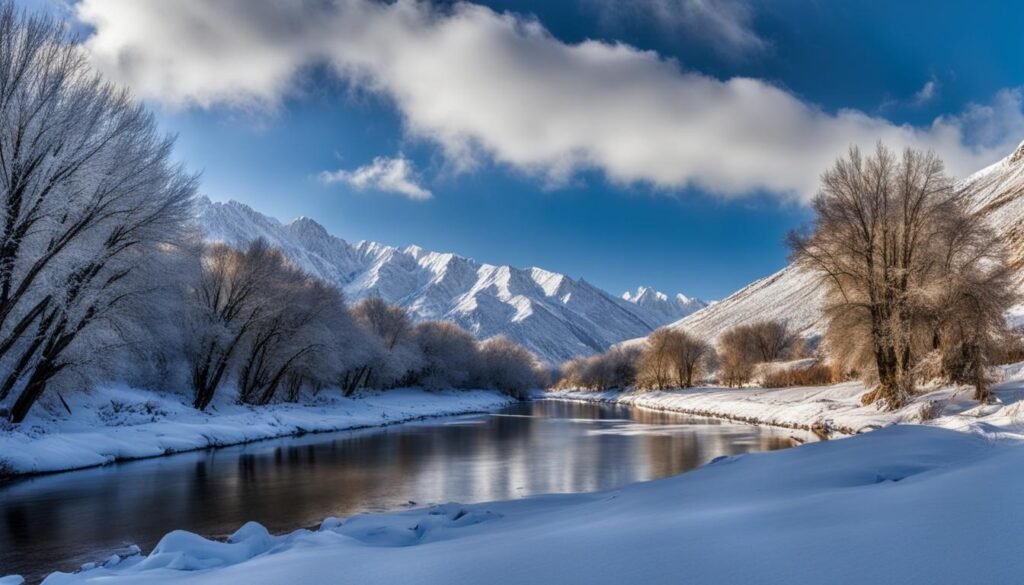Greetings! As a journalist always curious about unique weather phenomena, I found myself pondering a fascinating question: Does it snow in Iraq? Join me on this journey as we explore the rare occurrence of snowfall in one of the world’s hottest countries.
When we think of Iraq, we typically envision scorching temperatures and a harsh desert climate. Winter in Iraq is often associated with milder weather and relief from the blistering heat. But what about snow?
Snowfall is an extremely rare sight in Iraq, particularly in regions like Baghdad, the vibrant capital city. The last recorded snowfall in Baghdad was back in 2008, and even then, it was mostly slushy and short-lived. Prior to that, it had been an entire century since Baghdad witnessed any significant snowflakes.
However, we can’t overlook the fact that northern regions of Iraq, such as Mosul and Kurdistan, with their mountainous landscapes, do experience more frequent snowfall. These areas, located at higher altitudes, are naturally cooler and more conducive to winter precipitation. It’s here that Iraqis occasionally get to witness the magic of a snowy landscape.
Lately, Iraq has been grappling with extreme weather events, including water shortages, devastating flooding, and rampant wildfires. These incidents are indicative of the country’s changing climate and the challenges it faces in the midst of climate change.
Key Takeaways:
- Snowfall in Iraq is a rare phenomenon, especially in Baghdad.
- Northern regions, such as Mosul and Kurdistan, experience more frequent snowfall due to their mountainous terrain.
- Recent extreme weather events in Iraq, including flooding and wildfires, highlight the country’s changing climate.
- Climate change poses significant challenges for Iraq’s limited resources and infrastructure.
- Adapting to these changes requires both domestic and international efforts.
Rare Snowfall in Baghdad
Residents of Baghdad were surprised when the city woke up covered in white after only its second snowfall in a century. The snowfall occurred in 2022 and was the first time many Baghdad residents, both young and old, had ever seen snow falling in the city. The cold wave responsible for the snowfall was said to have come from Europe. Baghdad typically experiences scorching temperatures, with the highest recorded temperature reaching 51 degrees Celsius (124 degrees Fahrenheit).
Snow in Northern Kurdistan

Heavy snowfall is not uncommon in Iraq’s northern Kurdistan region, offering picturesque winter landscapes and embracing the inhabitants in a blanket of snow. The Amadiyah district in Dohuk Governorate and other areas in the region have experienced significant snowfall, with some places reporting depths of up to one meter. Snowfall in northern Iraq, particularly in the mountainous regions of Kurdistan, is more frequent compared to other parts of the country. The higher altitude of this region contributes to colder temperatures, creating the ideal conditions for snow to fall.
During the winter months, the Kurdistan region experiences these delightful snowfalls, transforming the surroundings into a winter wonderland. The charm of snow-covered mountains and landscapes captivates both residents and visitors, providing unique opportunities for outdoor activities and enjoying the beauty of nature.
Snowfall in Kurdistan
Snowfall in Kurdistan is a natural phenomenon that locals have become accustomed to. The region’s geographical position and higher elevation contribute to its colder climate, making it more susceptible to snowfall during the winter season. The snow offers recreational activities such as skiing, snowboarding, and snowshoeing, attracting tourists and providing a distinct experience in the heart of Iraq.
The table below highlights some key facts about snowfall in northern Kurdistan compared to other parts of Iraq:
| Region | Frequency of Snowfall | Snowfall Depth (average) |
|---|---|---|
| Kurdistan | More frequent | Higher |
| Other Parts of Iraq | Less frequent | Lower |
Unusual Winter Weather in Iraq

When it comes to winter weather, Iraq is not known for its frigid temperatures or snowy landscapes. In fact, the Iraqi winter climate is typically mild, with cold temperatures being relatively rare. However, in recent years, the country has experienced a shift in weather patterns, resulting in a series of extreme weather events that have caught many off guard.
From chronic water shortages to devastating flooding, wildfires, and even occasional heavy snowfall, Iraq has witnessed a range of unusual winter weather conditions. These events highlight the increasing challenges posed by climate change and the lack of adequate funding and infrastructure to cope with them.
Extreme Weather Events in Iraq
The Iraqi winter climate has become more unpredictable, leading to extreme weather events. These events have a significant impact on the lives of Iraqi citizens and the country as a whole. Here are some examples:
- Chronic Water Shortages: Iraq has been grappling with chronic water shortages, which have worsened during the winter months. Lack of rainfall and water mismanagement contribute to this issue, making it even more challenging for Iraqis to cope with their day-to-day lives.
- Deadly Flooding: Iraq is no stranger to flooding, especially during the winter season. Heavy rains combined with weak infrastructure and inadequate drainage systems lead to flash floods that can cause widespread devastation, displacing communities and causing loss of life.
- Wildfires: Unusual winter weather conditions have also contributed to an increase in wildfires across Iraq. Rising temperatures and drier conditions create a perfect environment for fires to ignite and spread quickly, posing additional risks to both human lives and the environment.
- Occasional Heavy Snowfall: While snowfall is rare in Iraq, there have been instances of heavy snowfall in recent years. These snowfalls can disrupt daily life in areas that are not accustomed to such winter conditions, leading to transportation issues and other challenges.
Climate Change and its Impact
The changing winter weather patterns in Iraq are clear indicators of the broader challenges posed by climate change. Rising temperatures, erratic rainfall, and extreme weather events are gradually transforming the country’s climate and exacerbating existing problems.
One of the significant consequences of climate change in Iraq is the desertification of once productive land. The environmental degradation resulting from climate change and water scarcity affects agricultural productivity, ultimately impacting the country’s food security and economy.
| Extreme Weather Events | Impact on Iraq |
|---|---|
| Chronic water shortages | Increased difficulties in daily life and challenges for agriculture |
| Deadly flooding | Devastation, displacement of communities, and loss of life |
| Wildfires | Environmental damage, risk to human lives, and habitat destruction |
| Occasional heavy snowfall | Disruption of daily life and transportation issues |
Addressing the impact of climate change requires urgent action, both domestically and internationally. Iraq needs sufficient funding and infrastructure to adapt to these changing weather patterns and mitigate the consequences of extreme winter conditions. Only through collective efforts can Iraq navigate the challenges posed by unusual winter weather and safeguard its future.
Baghdad’s Snowy Surprise
The snowfall in Baghdad in 2022 was a surprising and rare event for the residents of the city. It marked only the second recorded snowfall in a century, with the previous one occurring in 2008. While cold temperatures are unusual during Baghdad’s mild winters, the snowfall in 2022 was significant enough to transform the city into a temporary winter wonderland.
During this unexpected snowy episode, many residents couldn’t resist the opportunity to indulge in snowball fights and capture photographs of this extraordinary occurrence. Children and adults alike marveled at the sight of snow blanketing the streets and rooftops, creating a picturesque scene rarely witnessed in Baghdad.
This rare snowfall event added a touch of magic to the bustling city, providing a temporary escape from the typical desert climate. The snowy surprise proved to be a delightful and memorable experience for both locals and visitors.
The Impact of Snowfall in Iraq
Snowfall in Iraq can have both positive and negative impacts. On the positive side, it offers a rare opportunity for residents to enjoy winter activities and experience a different side of their country’s climate. The excitement of seeing snowflakes falling and being able to build snowmen or engage in snowball fights can create cherished memories for individuals, especially those who have never witnessed snowfall before. The beauty of snow-covered landscapes in unexpected places like Iraq can also inspire awe and wonder.
However, snowfall can also bring some challenges and disruptions to daily life, particularly in areas that are not accustomed to heavy snowfall. Infrastructure may not be prepared to handle the snow, leading to transportation delays and difficulties. Power outages can occur when heavy snow weighs down power lines and causes them to break. Snow accumulation can also create hazardous road conditions, increasing the risk of accidents. Residents may need to take extra precautions to stay safe and warm during the snowfall.
Furthermore, it is important to consider the larger implications of snowfall as an extreme weather event in Iraq. It serves as an indicator of the changing climate patterns in the region, which pose significant challenges for a country already dealing with limited resources and infrastructure. Snowfall is part of a broader climate change narrative, highlighting the need for sustainable practices and adaptation measures to address the long-term effects of climate change.
Examining the consequences of snowfall in Iraq through a climate change lens brings attention to the urgent need for environmental conservation and policy changes. The effects of snowfall, both positive and negative, serve as reminders of the importance of protecting our planet and ensuring the well-being of future generations.
Iraq’s Changing Climate
Iraq has been experiencing significant shifts in its climate in recent years, leading to changing climate patterns and presenting numerous challenges for the country. These changes are characterized by extreme temperatures, chronic water shortages, increased flooding, and the desertification of once productive land.
The impact of these climate changes is exacerbated by Iraq’s limited funding and infrastructure, which hinder its ability to adapt and respond effectively. As a result, Iraq faces numerous climate challenges that pose threats to its agricultural sector, water resources, and overall resilience.
Addressing these challenges requires collaborative efforts at both domestic and international levels. Iraq must invest in sustainable practices, develop robust infrastructure, and implement climate adaptation strategies to mitigate the effects of climate change.
The Impact of Changing Climate Patterns
The changing climate in Iraq has a profound impact on various aspects of the country:
- Agricultural Sector: The unpredictable climate patterns affect crop yields and agricultural productivity, jeopardizing food security for the population.
- Water Resources: Chronic water shortages, exacerbated by changing climate patterns, further strain Iraq’s limited water resources, leading to increased competition and potential conflicts.
- Resilience: Iraq’s ability to withstand and recover from climate-related disasters, such as flooding and extreme weather events, is compromised by limited resources and infrastructure.
It is crucial for Iraq to establish comprehensive strategies to mitigate these effects, promote sustainable practices, and strengthen resilience to adapt to the changing climate patterns.
The Need for Domestic and International Efforts
Addressing the climate challenges in Iraq requires a collaborative approach involving domestic and international efforts:
- Domestic Efforts: Iraq needs to prioritize climate change adaptation in its national policies. This includes investments in renewable energy, water management systems, and sustainable agriculture practices.
- International Cooperation: Support from the international community is crucial to assist Iraq in building climate resilience. This includes financial aid, technology transfer, and knowledge sharing to help Iraq overcome its climate challenges.
By fostering collaboration between different stakeholders, Iraq can navigate the changing climate landscape and build a more sustainable and resilient future.
Conclusion
Snowfall in Iraq is a rare and surprising event, particularly in regions like Baghdad where cold temperatures are uncommon. However, the occurrence of snowfall in recent years, even if infrequent, highlights the changing climate patterns in Iraq. The country is struggling to deal with extreme weather events, chronic water shortages, and other climate-related challenges. Adapting to these changes requires investments in infrastructure, sustainable practices, and international cooperation.
As Iraq continues to navigate these climate challenges, its people will witness the occasional snowy surprise amidst their predominantly hot climate. The rarity of snow in Iraq serves as a reminder of the unique and diverse climate that the country experiences. It signifies a shift in weather patterns and reinforces the need for comprehensive climate action.
While snowfall brings temporary joy and fascination, it also underscores the urgent need for Iraq to address the impacts of climate change. The country’s infrastructure and resources are already stretched thin, and the increasing occurrence of extreme weather events further exacerbates the challenges it faces. Iraq’s climate summary shows the importance of prioritizing resilience, sustainable practices, and international collaboration to build a more climate-resilient future.
FAQ
Does it snow in Iraq?
Snowfall is an extremely rare phenomenon in Iraq, one of the world’s hottest countries. The last recorded snowfall in Baghdad, the capital, was in 2008. However, it was a quick and mostly slushy affair. Prior to that, it had been a century since Baghdad saw any significant snowflakes. Snowfall is more common in northern Iraq, particularly in mountainous areas such as Mosul and Kurdistan.
When was the last snowfall in Baghdad?
The last recorded snowfall in Baghdad was in 2008. Prior to that, it had been a century since significant snowfall was seen in the city.
Is snow more common in northern Iraq?
Yes, snowfall is more common in northern Iraq, particularly in mountainous regions like Mosul and Kurdistan.
What kinds of extreme weather events has Iraq experienced in recent years?
Iraq has experienced a range of extreme weather events, including water shortages, deadly flooding, and wildfires.
When was the last snowfall in Baghdad?
The last recorded snowfall in Baghdad was in 2008. Prior to that, it had been a century since significant snowfall was seen in the city.
What were the conditions of the snowfall in Baghdad in 2022?
The snowfall in Baghdad in 2022 was significant enough to create a winter wonderland for a brief period. The cold wave responsible for the snowfall was said to have come from Europe.
How much snowfall was reported in the Kurdistan region?
Some areas in the Kurdish region reported up to one meter of snowfall, particularly in mountainous regions.
What are the climate challenges Iraq is facing?
Iraq is experiencing extreme temperatures, chronic water shortages, increased flooding, and the desertification of once productive land.
How does snowfall impact Iraq?
Snowfall in Iraq offers a rare opportunity for residents to enjoy winter activities, but it can also cause disruptions to daily life, especially in areas not accustomed to heavy snowfall. Additionally, it is an indicator of larger climate change patterns that pose challenges for Iraq’s limited resources and infrastructure.
What does the changing climate in Iraq mean for the country?
Iraq is struggling to deal with extreme weather events and climate-related challenges. Addressing these challenges requires investments in infrastructure, sustainable practices, and international cooperation.

Leave a Reply